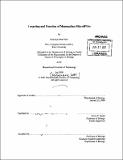| dc.contributor.advisor | David P. Bartel. | en_US |
| dc.contributor.author | Farh, Kyle Kai-How | en_US |
| dc.contributor.other | Massachusetts Institute of Technology. Department of Biology. | en_US |
| dc.date.accessioned | 2014-03-19T15:48:32Z | |
| dc.date.available | 2014-03-19T15:48:32Z | |
| dc.date.copyright | 2009 | en_US |
| dc.date.issued | 2009 | en_US |
| dc.identifier.uri | http://hdl.handle.net/1721.1/85834 | |
| dc.description | Thesis: Ph. D., Massachusetts Institute of Technology, Department of Biology, 2009. | en_US |
| dc.description | Cataloged from PDF version of thesis. | en_US |
| dc.description | Includes bibliographical references. | en_US |
| dc.description.abstract | In the span of a few short years, animal microRNAs have become recognized as broad regulators of gene expression, largely in part due to our improved understanding of how animal microRNAs recognize their targets. Crucial to microRNA targeting are the ~7-nt seed sites complementary to nucleotides 2-8 at the 5' end of the microRNA. We show that protein-coding genes preferentially expressed at the same time and place as a highly expressed microRNA have evolved their 3' UTR sequence to specifically avoid seed sites matching that microRNA. In contrast, conserved sites appear to be preferentially expressed in developmental states prior to microRNA expression, and are downregulated upon induction of that microRNA. Combined with the result that both conserved and nonconserved seed sites are generally functional, our findings extend the direct and indirect influence of mammalian microRNAs to the majority of protein-coding genes. Although seed sites account for much of the specificity of microRNA regulation, they are not always sufficient for repression, suggesting the contribution of additional specificity determinants. Combining independent computational and experimental approaches, we found five general features associated with site efficacy: AU-rich nucleotide composition near the site, proximity to sites for coexpressed microRNAs, pairing outside of the seed region at microRNA nucleotides 13-16, and positioning within the 3' UTR at least 15nt from the stop codon and away from the center of long UTRs. By incorporating these five features, we are able to explain much of the differences in site efficacy for both exogenously added microRNAs and for endogenous microRNA-message interactions. We further refined the seed site motif involved in microRNA repression, by demonstrating experimentally an Adenosine preference across from the unpaired first nucleotide of the microRNA and ranking the relative effectiveness of different classes of seed sites. Although sites lacking perfect seed pairing were generally ineffective, a fraction of these sites were supplemented by detectable compensatory 3' pairing. In addition, by extending our conservation analysis to 11 genomes, we show that the confidence with which conserved target sites can be predicted is a function of the conservation of the seed site itself relative to the conservation of surrounding sequence. This allows individual conserved sites to be assigned a confidence score reflecting the likelihood that the site is being conserved due to selection rather than by chance. | en_US |
| dc.description.statementofresponsibility | by Kyle Kai-How Farh. | en_US |
| dc.format.extent | 172 pages | en_US |
| dc.language.iso | eng | en_US |
| dc.publisher | Massachusetts Institute of Technology | en_US |
| dc.rights | M.I.T. theses are protected by copyright. They may be viewed from this source for any purpose, but reproduction or distribution in any format is prohibited without written permission. See provided URL for inquiries about permission. | en_US |
| dc.rights.uri | http://dspace.mit.edu/handle/1721.1/7582 | en_US |
| dc.subject | Biology. | en_US |
| dc.title | Targeting and function of mammalian microRNAs | en_US |
| dc.type | Thesis | en_US |
| dc.description.degree | Ph. D. | en_US |
| dc.contributor.department | Massachusetts Institute of Technology. Department of Biology | |
| dc.identifier.oclc | 872277705 | en_US |
